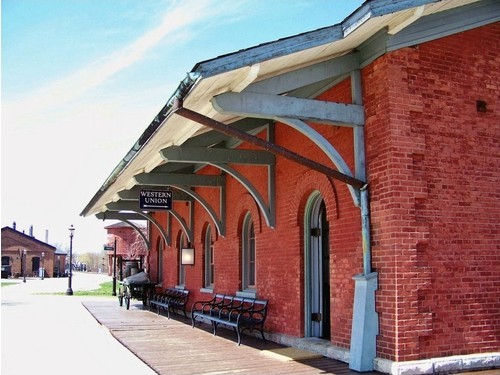Americana: Michigan
22 Sep - 10 Oct 2009

Smith's Creek Depot. Built in 1858 near Port Huron, MI, functioned as a telegraph office, parcel post station, and stationmaster's residence. Image courtesy Maia C (Flickr: Creative Commons).
AMERICANA: MICHIGAN
Panorama of Life
Mary Augustine Gallery | Sept. 22–Oct. 10, 2009
Greenfield Village is a full-scale Americana, a collection of artifacts related to the history and cultural heritage of the United States, in Dearborn, Michigan. Considered to be the largest outdoor museum in the country, Greenfield Village includes eighty-three buildings that were moved from their original locations and placed into a village arrangement. These structures sit on ninety acres of engineered landscape, within 240 acres of forest and pasture. Some of the most notable buildings include Noah Webster's house, where he wrote the first American dictionary, Thomas Edison's laboratories, the courthouse where Abraham Lincoln practiced law, and the Wright Brothers' home and workshop.
Founded by Henry Ford, the man credited with changing the course of US history with the invention of the assembly line, it is part of the much larger Henry Ford Museum. The Village opened in 1933 to display original (not prototype) key items that embody cultural, aesthetic, and technological developments in the history of the United States, according to Ford. He believed that the experience of these notable spaces would help visitors understand America, through full sensory immersion. This archive can be understood as a portrait of Ford (and his concerns, which in the 1920s and 30s, included Nazism), and as such there are undoubtedly stories that are untold, elements of American history that are absent. As with all historical narratives, one must question how these physical structures add to or take away from the powerful interests of corporations, governments, and the wealthy.
Henry Ford's village was assembled from disparate American architectural structures; the collection creates not only a physical town but also a psychic history of the United States. All are brought together in one imaginary town, thus collapsing and erasing the specificities of time and place. The use value of each structure is transformed into aesthetic value via Ford's act of collecting, removed from their contexts and placed side by side along the winding streets. The buildings are re-animated by costumed presenters who make era-appropriate crafts and speak in dialects that reference the buildings' histories.
In this exhibition, miniatures of the primary buildings in Greenfield Village are presented to simulate the way that Ford created an entirely new place with old "authentic" buildings. The paper structures and their descriptions included in this display raise questions about the validity and truth of Ford's full-scale "real" version of history. By reconfiguring these pieces of American history to tell a particular story, Ford's process was akin to the formation of American identities: borrowing bits from the past, ignoring the parts that were unacceptable or troubling, to construct a new story in a new land.
Curated by Courtney Dailey
Panorama of Life
Mary Augustine Gallery | Sept. 22–Oct. 10, 2009
Greenfield Village is a full-scale Americana, a collection of artifacts related to the history and cultural heritage of the United States, in Dearborn, Michigan. Considered to be the largest outdoor museum in the country, Greenfield Village includes eighty-three buildings that were moved from their original locations and placed into a village arrangement. These structures sit on ninety acres of engineered landscape, within 240 acres of forest and pasture. Some of the most notable buildings include Noah Webster's house, where he wrote the first American dictionary, Thomas Edison's laboratories, the courthouse where Abraham Lincoln practiced law, and the Wright Brothers' home and workshop.
Founded by Henry Ford, the man credited with changing the course of US history with the invention of the assembly line, it is part of the much larger Henry Ford Museum. The Village opened in 1933 to display original (not prototype) key items that embody cultural, aesthetic, and technological developments in the history of the United States, according to Ford. He believed that the experience of these notable spaces would help visitors understand America, through full sensory immersion. This archive can be understood as a portrait of Ford (and his concerns, which in the 1920s and 30s, included Nazism), and as such there are undoubtedly stories that are untold, elements of American history that are absent. As with all historical narratives, one must question how these physical structures add to or take away from the powerful interests of corporations, governments, and the wealthy.
Henry Ford's village was assembled from disparate American architectural structures; the collection creates not only a physical town but also a psychic history of the United States. All are brought together in one imaginary town, thus collapsing and erasing the specificities of time and place. The use value of each structure is transformed into aesthetic value via Ford's act of collecting, removed from their contexts and placed side by side along the winding streets. The buildings are re-animated by costumed presenters who make era-appropriate crafts and speak in dialects that reference the buildings' histories.
In this exhibition, miniatures of the primary buildings in Greenfield Village are presented to simulate the way that Ford created an entirely new place with old "authentic" buildings. The paper structures and their descriptions included in this display raise questions about the validity and truth of Ford's full-scale "real" version of history. By reconfiguring these pieces of American history to tell a particular story, Ford's process was akin to the formation of American identities: borrowing bits from the past, ignoring the parts that were unacceptable or troubling, to construct a new story in a new land.
Curated by Courtney Dailey
